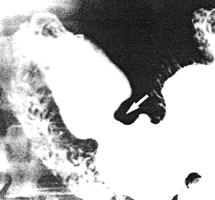



Go to chapter: 1 | 2 | 3 | 4 | 5 | 6 | 7 | 8 | 9 | 10 | 11 | 12 | 13 | 14 | 15 | 16 | 17 | 18 | 19 | 20 | 21 | 22 | 23 | 24 | 25 | 26 | 27 | 28 | 29 | 30 | 31 | 32 | 33 | 34 | 35 | 36 | 37 | 38 | 39
Chapter 27 (page 127)
The main advantages of this method appear to be the following:
- Because of the clear images produced by radiography, the diameter and
competence of the pylorus may be studied in relation to both duodenal contraction
waves and the motility of the pyloric part of the stomach, i.e. the pyloric
sphincteric cylinder. Little attention has been paid to duodenogastric reflux in
relation to pyloric motility in previous investigations.
- If it is assumed that the barium suspension in the duodenal lumen represents
duodenal contents, the procedure will determine the presence or absence of reflux
of duodenal contents, i.e. of duodenal juice (in contrast to bile only).
- No medication (e.g. anticholinergics or cholecystokinin) is administered, thus
allowing the study of pyloric competence in the absence of pharmacological
modification.
- There is no gastric intubation (thus eliminating nausea) and the pylorus is not
traversed by a tube (or has been traversed immediately before observation, as in
the test of Keighley et al. l975).
- The test is quick and simple to perform, and may be followed by a "conventional"
upper gastrointestinal radiographic examination.
- Radiation to the patient should be considered, but measurements showed that this
was minimal and could be discounted since a small (11.0 x 8.0 cm), localized
aperture was used, not more than two 11.0 x 8.0 cm film exposures were needed
for record purposes, and screening time generally did not exceed 90 to 120
seconds.
- In a minority of patients, depending on the direction of the pyloroduodenal axis, it
may not be possible to obtain a side view of the duodenum and pylorus, the
barium-filled bulb being projected over the pyloric aperture.
- The examination is performed in the interdigestive phase and in the supine
position only.
- While there is no doubt about the ability of the procedure to illustrate the presence
or absence of reflux, quantification cannot be accurate as only a rough impression
of the quantity of reflux is gained.
Having received approval of the Ethical Committee, the test was performed in 14
informed, volunteer, asymptomatic male medical students between the ages of 23 and 27
years. In 9 of the subjects no duodenogastric reflux occurred. In 2 subjects there was
minimal reflux on one occasion only (three further "rotating manoeuvres" failed to
produce reflux). In 3 subjects moderate reflux occurred. In each it was seen two or three
times during four "rotating manoeuvres". One of these subjects was re-tested a week
later, with similar results.
Duodenal Motility
In all 14 normal subjects duodenal peristalsis appeared normal on the TV monitor and the
duodenum emptied normally. In all there also occurred retrograde movement of barium
in the duodenal lumen, which appeared to result from "segmental" contraction waves in
the third part of the duodenum. While these contractions did not proceed along the
duodenal walls, but remained localized to the third part, they forced barium in an orad
direction, at times as far as the bulb; barium in the lumen distal to these contractions was
forced in an aborad direction.
In all normal subjects the second part of the duodenum was also compressed as far as
possible by means of the gloved hand on the anterior abdominal surface. This did not
occlude the lumen completely, did not prevent aborad movement, and did not initiate
retrograde movement. The results were the same with and without partial compression of
the second part of the duodenum.
Pyloric Motility
As indicated previously (Chap. 3), the muscular part of the pyloric ring is considered to
be the terminal annular thickening of the pyloric sphincteric cylinder, as described by
Cunningham (1906), Forssell (l913) and Torgersen (l942). The cylinder, which is 3.0 to
4.0 cm in length, normally contracts in a segmental (as opposed to "peristaltic") way
(Chap. 13). As the ring forms an inherent part of the cylinder, it closes and opens with
contraction and relaxation of the cylinder respectively. In all subjects these contractions
were normal. Reflux in the 5 subjects occurred either during maximal relaxation of the
sphincteric cylinder, (Fig. 27.2), or when it was in a state of partial contraction (Fig.
27.3). It never occurred during maximal contraction of the cylinder.
 |
Fig. 27.3.
Barium filling to show partial contraction of sphincteric cylinder. At this stage
the pyloric aperture (arrow) is widely patent
|
Previous Page | Table of Contents | Next Page
© Copyright PLiG 1998







